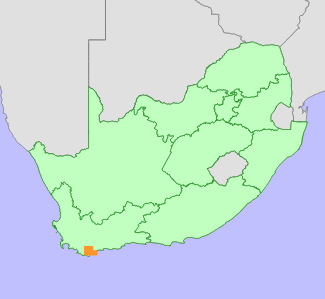|
Scientific Name | Aspalathus pycnantha R.Dahlgren |
Higher Classification | Dicotyledons |
Family | FABACEAE |
National Status |
Status and Criteria | Vulnerable A2c; B1ab(iii,v)+2ab(iii,v) |
Assessment Date | 2006/03/16 |
Assessor(s) | N.A. Helme, D.I.W. Euston-Brown & D. Raimondo |
Justification | A population reduction of at least 40% is estimated based on habitat loss to wheat, vineyard and protea cultivation over the past 40 years (generation length suspected to be 15 years). Current EOO and A OO<1200 km², ± eight remaining locations are declining due to ongoing habitat degradation as a result of alien plant invasion and livestock grazing. |
Distribution |
Endemism | South African endemic |
Provincial distribution | Western Cape |
Range | Bredasdorp. |
Habitat and Ecology |
Major system | Terrestrial |
Major habitats | Central Ruens Shale Renosterveld, Elim Ferricrete Fynbos |
Description | Gravely shale lowlands. |
Threats |
| Habitat degradation, Invasive Alien Species (direct effects), Habitat loss |
Population |
Population trend | Decreasing |
Assessment History |
Taxon assessed |
Status and Criteria |
Citation/Red List version | | Aspalathus pycnantha R.Dahlgren | VU A2c; B1ab(iii,v)+2ab(iii,v) | Raimondo et al. (2009) | |
Bibliography |
Dahlgren, R. 1988. Crotalarieae (Aspalathus). In: O.A. Leistner (ed). Flora of southern Africa 16 Fabaceae, Part 3 Papilionoideae, Fascicle 6:1-430. National Botanical Institute, Pretoria.
Goldblatt, P. and Manning, J.C. 2000. Cape Plants: A conspectus of the Cape Flora of South Africa. Strelitzia 9. National Botanical Institute, Cape Town.
Raimondo, D., von Staden, L., Foden, W., Victor, J.E., Helme, N.A., Turner, R.C., Kamundi, D.A. and Manyama, P.A. 2009. Red List of South African Plants. Strelitzia 25. South African National Biodiversity Institute, Pretoria.
|
Citation |
| Helme, N.A., Euston-Brown, D.I.W. & Raimondo, D. 2006. Aspalathus pycnantha R.Dahlgren. National Assessment: Red List of South African Plants version 2024.1. Accessed on 2025/10/26 |
 Comment on this assessment
Comment on this assessment


